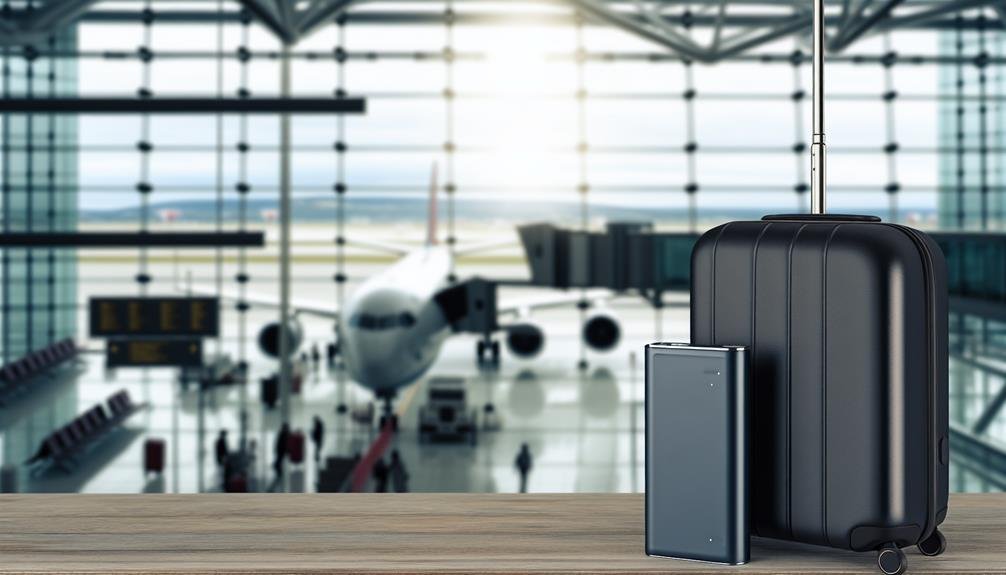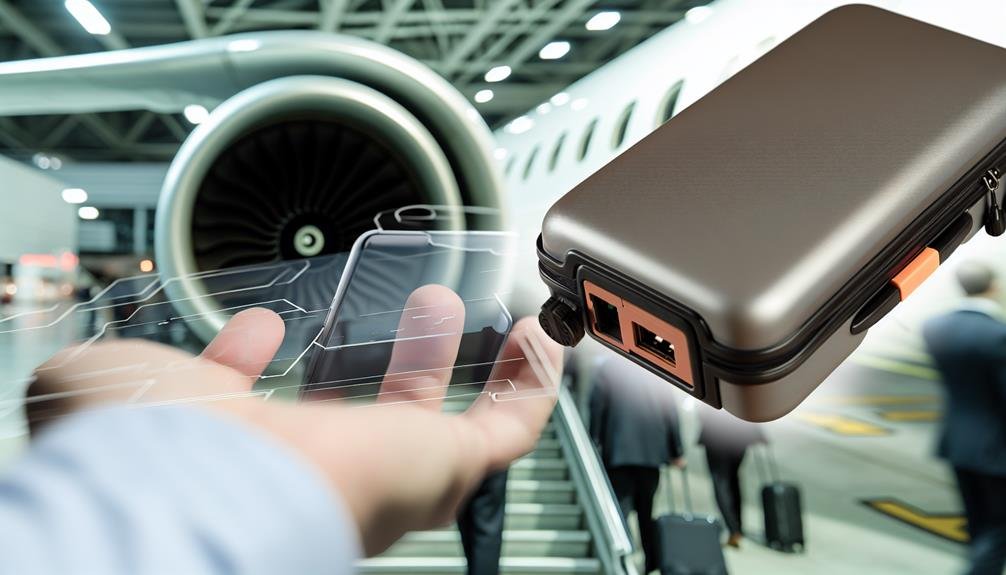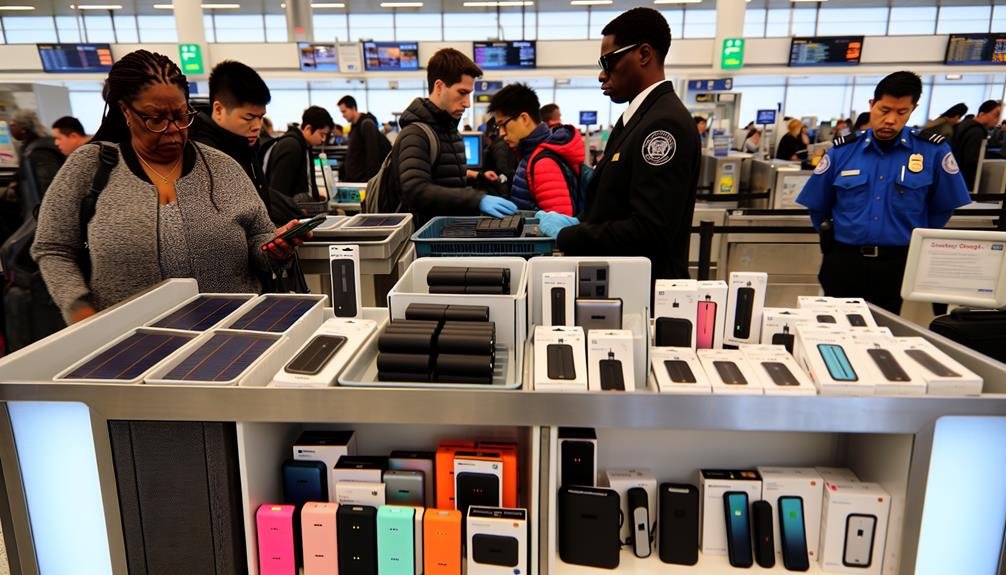Yes, you can pack your power bank in your hand luggage, but there are regulations to follow. Power banks must be in carry-on bags and not checked luggage. Most airlines allow power banks up to 100Wh without approval. Between 100Wh and 160Wh, you might need airline approval. Anything over 160Wh is generally prohibited. Safety is key since lithium batteries can overheat. Make sure the capacity is clearly labeled and check specific airline rules beforehand. Packing it properly in a designated pocket also helps. For thorough tips on ensuring a smooth experience, learning about these guidelines further will be beneficial.
Airline Regulations

When traveling by air, it's important to understand the airline regulations regarding power banks in hand luggage. The TSA guidelines are quite clear: power banks must be carried in your carry-on luggage, not in checked bags. This rule applies to both domestic and international flights. The main reason behind this restriction is the potential fire risk posed by lithium-ion batteries.
Most airlines have specific restrictions that you need to be aware of. Generally, power banks with a capacity of up to 100 watt-hours (Wh) are allowed in your carry-on without prior approval. If your power bank has a capacity between 100Wh and 160Wh, you might need to get airline approval before you can bring it on board. Anything above 160Wh is typically prohibited.
When packing your carry-on luggage, make sure to place your power bank in an easily accessible location. You might be asked to remove it during the security screening process for a closer inspection. Also, keep in mind that you're usually limited to carrying a maximum of two power banks.
Safety Concerns
Safety concerns surrounding power banks primarily revolve around the risk of overheating and potential fire hazards. Power banks often contain lithium batteries, which are known to be volatile under certain conditions. When these batteries overheat or are damaged, they can catch fire, posing a serious threat, especially in the confined space of an aircraft.
To lessen these risks, airport security enforces strict regulations regarding power bank size and voltage limitations. You'll need to make sure your power bank complies with these guidelines to avoid confiscation or denial of boarding. The primary focus is on the watt-hour (Wh) rating of the power bank, which must fall within specific limits to be considered safe for air travel.
Understanding and adhering to these rules is vital for your safety and the safety of fellow passengers. Airport security personnel are trained to spot non-compliant devices, so it's crucial to know the specifications of your power bank before you travel. Always check the manufacturer's details regarding voltage limitations and power bank size to ensure compliance.
Allowed Capacity

To guarantee your power bank is permitted in hand luggage, it's vital to comprehend the allowed capacity limits set by airlines. Most airlines have specific restrictions on the maximum capacity of power banks you can carry. Typically, power banks up to 100 watt-hours (Wh) are allowed without special permissions. However, if your power bank's capacity ranges between 100Wh and 160Wh, you might need prior approval from the airline.
Here's a quick reference table to help you navigate these airline restrictions:
| Capacity (Wh) | Approval Needed | Quantity Allowed |
|---|---|---|
| Up to 100Wh | No | Multiple |
| 100Wh – 160Wh | Yes | Usually 2 per person |
| Above 160Wh | Not Allowed | N/A |
Always check with your specific airline, as rules can vary. It's also essential to verify your power bank clearly displays its capacity. If the capacity is not marked or is illegible, security may confiscate it for safety reasons.
Packing Tips
Make certain you pack your power bank in your carry-on bag, as airlines prohibit them in checked luggage. For a smooth journey, keep your carry-on essentials well-organized. Start by designating a specific pocket or compartment for your travel gadgets. This will make it easy to find them quickly and guarantee they remain undamaged during transit.
When packing, place your power bank and other charging solutions in a protective case to avoid accidental activation or damage. This not only ensures safety but also keeps your devices in prime condition. Label your power bank clearly, especially if it's a high-capacity model, to avoid any confusion during security checks.
Utilize organization tips like packing cubes or pouches to keep your carry-on tidy. This helps you maximize space while maintaining easy access to your essentials. Remember, a well-organized bag reduces stress and allows you to focus on enjoying your trip.
Lastly, ensure all travel gadgets, including your power bank, are fully charged before you leave. This provides a reliable backup in case you encounter delays, making your journey more comfortable and secure.
Alternative Options

If you're considering alternatives to traditional power banks, there are several options to explore. Solar-powered banks offer eco-friendly charging, while portable chargers with higher battery capacities can keep your devices running longer. Assess your needs and choose the option that best fits your travel requirements.
Portable Charger Alternatives
When considering substitutes for power banks for your hand luggage, solar chargers and battery phone cases are practical options. These power bank alternatives can guarantee your devices stay charged without the need to carry bulky power banks, which might face restrictions during air travel. Charging stations at airports can also be unreliable due to high demand, making portable solutions essential travel essentials.
Solar chargers harness the sun's energy, providing a renewable power source. They're particularly useful if you're traveling to sunny destinations. On the other hand, battery phone cases combine protection and power in one compact unit, perfect for those who need a seamless solution.
To help you compare these alternatives, here's a quick guide:
| Alternative | Advantages | Considerations |
|---|---|---|
| Solar Chargers | Renewable, eco-friendly, unlimited power source | Dependent on sunlight, slower charging |
| Battery Phone Cases | Compact, dual-purpose (protection + power) | Limited capacity, specific to phone model |
| Charging Stations | No need to carry extra gear | High demand, limited availability |
Solar-Powered Banks
Solar-powered banks offer a sustainable and convenient way to keep your devices charged during travel. They harness the power of the sun, making them an eco-friendly alternative to traditional power banks. To make sure you're selecting the right solar-powered bank, consider these key factors:
- Solar Panel Efficiency: Look for models with high-efficiency solar panels. This means they can convert more sunlight into usable energy, which is essential when you have limited exposure to direct sunlight.
- Charging Time: Be aware that solar-powered banks typically take longer to charge compared to regular power banks. Opt for models that can still hold a significant charge even with shorter sunlight exposure.
- Portability: Choose a compact and lightweight design that fits easily into your hand luggage. This guarantees you can carry it around without adding extra bulk.
- Durability: Confirm the solar-powered bank is built to withstand outdoor conditions. Look for features like water resistance and shockproof materials to keep it safe during your travels.
Battery Pack Capacity
Beyond solar-powered options, understanding battery pack capacity is essential for choosing the right power bank for your travel needs. Airlines impose strict rules on power bank capacity due to safety concerns. Most allow power banks up to 100 watt-hours (Wh) without prior approval, aligning with standard charging limits and battery safety protocols.
When selecting a power bank, check its capacity, typically measured in milliampere-hours (mAh). To convert mAh to Wh, use this formula: (mAh) x (Voltage) / 1000 = Wh. For example, a 20,000 mAh power bank operating at 3.7 volts has a capacity of 74 Wh, well within most airlines' limits.
Travel restrictions vary, so always verify with your airline before flying. Power banks exceeding 100 Wh but under 160 Wh might be allowed with airline approval, but anything beyond that is generally prohibited in hand luggage. This guarantees compliance with charging limits and enhances battery safety.
Opt for reputable brands and check for certifications like CE or UL, which indicate rigorous battery safety testing. By understanding power bank capacity and adhering to travel restrictions, you can safely carry your essential charging device without hassle. Always prioritize safety and adherence to ensure a smooth travel experience.
Common Mistakes
When traveling with a power bank, you must be aware of the capacity limits set by airlines, as exceeding them can lead to confiscation. Don't forget to pack your power bank properly to prevent short circuits or damage. Understanding these common mistakes will help you avoid unnecessary hassles during your journey.
Incorrect Capacity Limits
One common error travelers make is bringing power banks that surpass the airline's capacity limits. Adhering to airline rules is crucial for a smooth journey, and power bank weight and battery pack size play a significant role in these regulations. Airlines have specific carry-on restrictions that you must follow for safety and compliance.
Here are key points to keep in mind:
- Know the Limits: Airlines typically allow power banks with a capacity of up to 100 watt-hours (Wh) without prior approval. If your power bank exceeds this, you may need special permission or it might not be allowed at all.
- Check Battery Specifications: Confirm your power bank's capacity is clearly labeled, and cross-check it with the airline's guidelines. Some power banks may not display their capacity in watt-hours, so you may need to convert from milliamp-hours (mAh).
- Keep It Within Weight Limits: While weight is generally less of a concern than capacity, excessively heavy power banks can still pose issues. Verify the power bank weight aligns with the airline rules.
- Be Prepared for Security Checks: Security personnel may ask you to show your power bank's specifications. Having this information readily available will expedite the process and make sure you're not delayed.
Improper Packing Techniques
While knowing the capacity limits is essential, how you pack your power bank is equally significant to guarantee safety and compliance. Improper packing techniques can lead to significant overloading risks, posing a threat to both your device and your overall safety. To avoid these risks, make sure proper organization within your hand luggage. Your power bank should be placed in a designated pocket or compartment, away from sharp objects and other electronic devices. This minimizes the potential for physical damage during transit.
Security checks are another vital consideration. If your power bank is buried deep within your luggage, it can delay the screening process and raise red flags for security personnel. Always pack your power bank in an easily accessible location to facilitate quick inspection. Additionally, avoid packing it alongside metallic or dense items, as these can obscure the power bank during X-ray screening, leading to potential delays and further investigation.
Lastly, consider potential damage from improper packing. A power bank that's loosely packed can shift around, causing internal components to become dislodged or damaged. By following these guidelines, you not only ensure compliance with airline regulations but also enhance the safety of your travel experience.
Frequently Asked Questions
How Long Does a Power Bank Typically Last?
With a power bank's capacity and charging speed in mind, it typically lasts 2-3 years or 300-500 charge cycles. Confirm your power bank's in good condition to maintain safety and performance standards.
Can Power Banks Charge Laptops?
Did you know that 60% of power banks have laptop compatibility? When selecting one for travel, confirm it meets airline regulations regarding charging capacity. Always check travel restrictions to keep your journey smooth and safe.
Are There Eco-Friendly Power Bank Options?
Yes, there are eco-friendly power bank options. They're crafted from sustainable materials and utilize renewable energy sources like solar power. These choices guarantee you're charging your devices safely while minimizing environmental impact.
How Do I Dispose of an Old Power Bank?
Of course, just toss that old power bank in the trash—if you want a fire hazard. Seriously, recycle it at an e-waste center or donate it to a charity that refurbishes electronics. Safety first!
What Are the Best Brands for Reliable Power Banks?
When comparing portable chargers, consider brands like Anker, RavPower, and Aukey. They offer high charging capacity and essential safety features. These brands consistently receive top reviews for their reliability and durability in various comparison tests.



